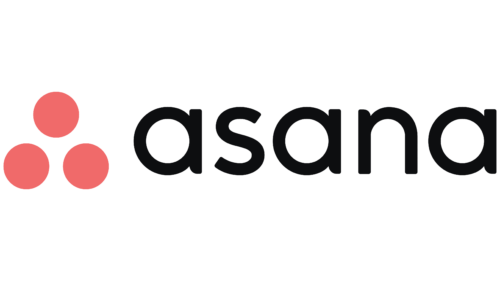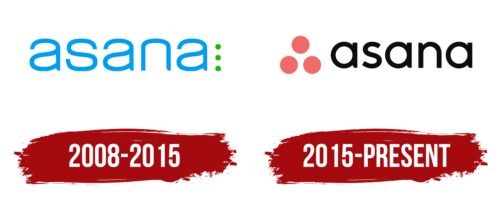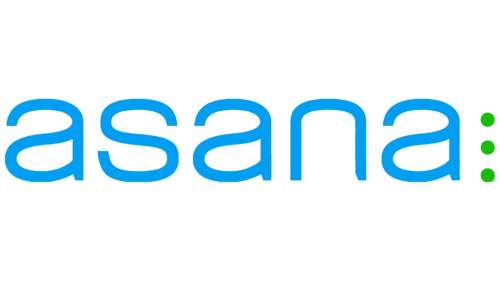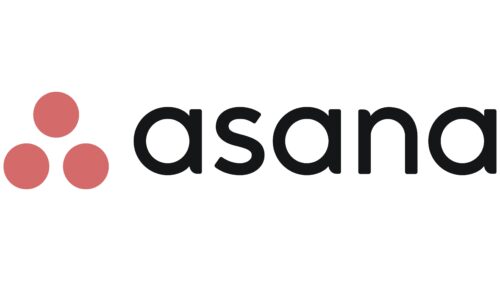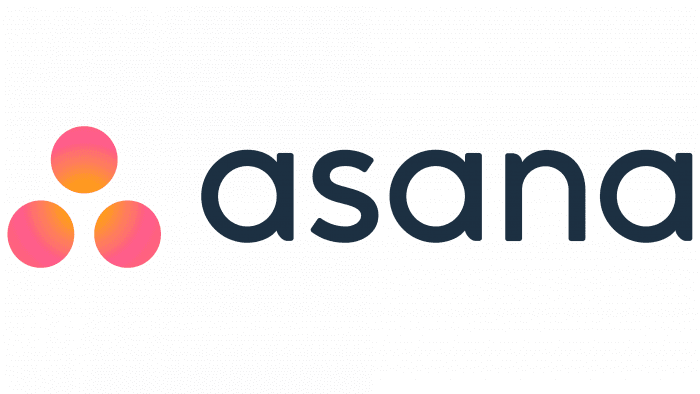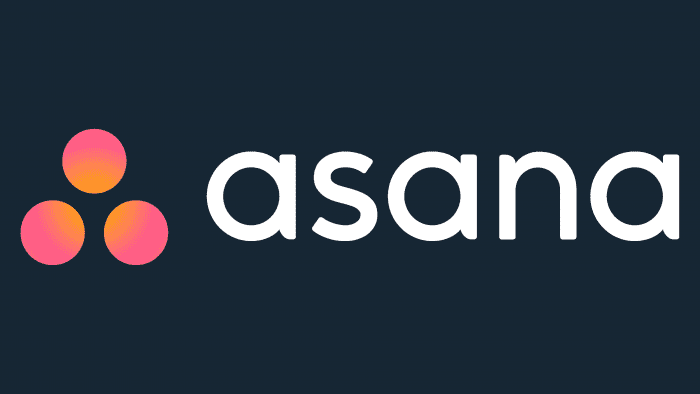The ability to rise above problems, communicate and work in a team is encrypted in the symbols of the Asana logo. The image shows the birth of an ideal solution when efforts are combined. The emblem is a sample of technologies on guard of democracy and equality.
Asana: Brand overview
| Founded: | 2008 |
| Founder: | Dustin Moskovitz, Justin Rosenstein |
| Headquarters: | San Francisco, California, US |
| Website: | asana.com |
Meaning and History
The Asana app has evolved thanks to the healthy self-criticism of Rosenstein and Moskovitz. The developers realized that users did not like the boring interface, so they decided to redesign a small redesign to eliminate the dullness. But in the process, difficulties arose: a new style of illustrations, improved typography, and a light color palette had to match the logo. Until 2015, it looked like a simple lowercase letter “a” in blue with three vertically spaced pale green dots.
The company owners did not know what this graphic composition meant: either a list of items or some listing. Therefore, it was not at all difficult to abandon the brand name. In a meeting hosted by Amanda’s chief designer, the team decided to change their perception of the Asana brand, although the result seemed hazy. They began a cautious experiment and could not resist and did a colossal work on the corporate style.
Moving Brands helped identify key landmarks to embody a new philosophy in visual identity. They proposed several variants of the logo, one of which looked like three dots arranged in a triangle. Two more versions contained other elements, but they were not iconic for Asana.
It took just over a month to learn all the concepts. Designers watched their development, viewed them in different contexts – and still returned to iconic points. They had to adjust the distance between the circles and polish the word mark, giving the letters the desired shape. A whole system was created in the final stage, including a new color scheme and interface fonts.
The Asana logo has two versions: vertical and horizontal. They differ only in the arrangement of the pink circles that give the brand a personality. These geometric shapes are the evolution of the classic dots that once complimented the letter “a.” But now, they are not lined up but are opposite each other, symbolizing close interaction.
In turn, the triangular shape looks like an upward pointing arrow, a capital “A” and the mathematical sign “therefore.” True, not all representatives of the company liked this emblem. Some thought it looked like the outline of the Predator laser sight from a sci-fi action movie.
What is Asana?
This is the common name of the company, which was founded in the American city of San Francisco in 2008, and its main product is project management software. Software development helps teams assign and track tasks and provides several other useful features.
2008 – 2015
The Asana logo consists of two parts: verbal and graphic. The name is located first. It occupies the vast majority of the emblem, as it consists of large bold letters. They have rounded corners, smooth transitions, and smooth sides. All glyphs are lowercase and aquamarine.
Moreover, “n” resembles an inverted bracket or a high arch because it lacks a side stroke. To the right of the inscription are three green dots. They are lined up vertically and do not go beyond the word “asana,” remaining slightly below it.
2015 – today
After changing the concept, the company adopted the logo in a new design. Everything has undergone a change – both typography and image. As a result, a different font appeared – also lowercase and rounded, but with an identical side element for all letters. This helped to unify the inscription visually. Three dots are located in front of the company name. Now they are large, pink, and folded in a triangle shape. As conceived by the staff of the Moving Brands studio, they symbolize an upward arrow, which indicates the growing possibilities of the brand.
Asana: Interesting Facts
Asana is a tool designed to help teams plan, track, and manage their tasks easily, and it’s come a long way since it started.
- Founders’ Dream: Asana was started in 2008 by Dustin Moskovitz (a Facebook co-founder) and Justin Rosenstein (who worked at Facebook and Google) to reduce endless email threads and improve teamwork.
- Name’s Meaning: “Asana,” from Sanskrit, refers to a steady and comfortable yoga pose—symbolizing the founders’ goal of smooth work management.
- Growth Over Time: Officially launched in 2011, Asana now helps millions around the globe, from small groups to big companies, keep their projects on track.
- Task Management Innovator: Asana helped change how tasks are managed by letting teams break down goals, assign tasks, and set deadlines in one place.
- Feature-Rich Platform: Asana is known for its wide range of tools, such as project templates and timelines, and its easy integrations with other apps like Slack and Google Drive. It fits various work needs.
- Unique Work Graph: With its Work Graph data model, Asana shows how different tasks are connected, helping teams plan and execute projects more clearly.
- Worldwide Presence: Headquartered in San Francisco, Asana has grown internationally, with offices in Dublin, Sydney, and Tokyo catering to a global audience.
- Award-Winning Culture: Asana has been recognized for its innovative product and great workplace culture, earning spots on lists by Fast Company, Fortune, and Forbes.
- Mindful Work Environment: Its founders emphasize mindfulness at work, striving to balance being productive and maintaining mental health.
- Public Company: In 2020, Asana went public on the New York Stock Exchange, a major step that highlighted its growth and presence in the work management software scene.
- Eco-Friendly Efforts: Committed to reducing its carbon footprint, Asana also supports environmental projects worldwide, showing its dedication to business success and the planet.
From its beginnings to becoming a top choice for project management, Asana’s journey reflects its mission to make teamwork more efficient and less stressful.
Font and Colors
The typography and color of the logo convey a sense of balance. The font was developed in close collaboration between Moving Brands and Asana’s corporate designers. The improved lettering is the cornerstone of the brand’s modern identity: it consists of proportional circular letters with unusual cuts at the edges.
The palette is very different from what it was before. Until 2015, the program used a blue-green icon, which was boring to many. To become a “multi-colored narwhal,” as designer Micah Daigle put it, she switched to bright pinks and yellows. This color combination was inspired by a concept created during the sketching experiment. The bright gradient symbolizes the flow of energy. It is balanced by the word “asana,” written in dark blue (# 283343) letters.
FAQ
What is the concept of the Asana logo?
The logo features three dots arranged in a triangular pattern, forming an abstract ‘A.’ This design symbolizes the limitless potential of people working together, highlighting collaboration and unity.
The logo’s simplicity and elegance convey clarity and focus, aligning with Asana’s goal of helping teams stay organized and efficient. The abstract ‘A’ represents the company’s name and suggests connectivity and collective effort.
What is the purpose of the Asana brand?
The company aims to help humanity thrive by enabling teams to work together effortlessly. The mission is to improve collaboration and productivity, making it easier for teams to reach their goals.
In a world where things seem negative, the company focuses on the positive impact of teamwork and efficiency. The brand provides tools to streamline workflows and enhance communication, helping teams tackle challenges and achieve more. By fostering a collaborative environment, aims to contribute to a better world through improved teamwork and productivity.
What does the Asana logo mean?
The logo has three pink circles with an orange gradient, symbolizing connection, cohesion, and cooperation. These circles form a triangle, representing the capital “A” for Asana.
The design reflects balance and harmony, aligning with Asana’s goal of creating a seamless and productive work environment. The circles represent unity and teamwork, while the triangle highlights structure and organization.
What font is the Asana logo?
The logo features three circles and a wordmark in lowercase, rounded sans-serif letters. Corporate designers and experts from Moving Brands created the custom font for the name “Asana.”
This custom font emphasizes simplicity, clarity, and modern design. The rounded letters convey approachability and friendliness, aligning with Asana’s mission to enhance teamwork and productivity. The unique wordmark design complements the logo, creating a cohesive and recognizable brand identity.
